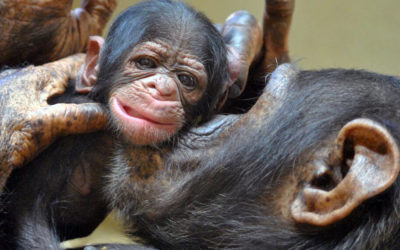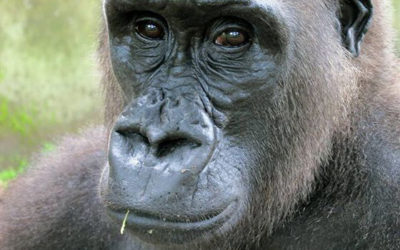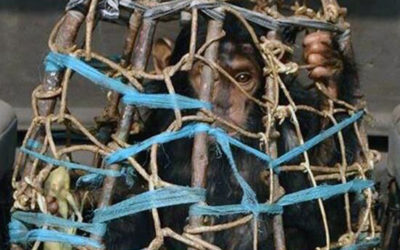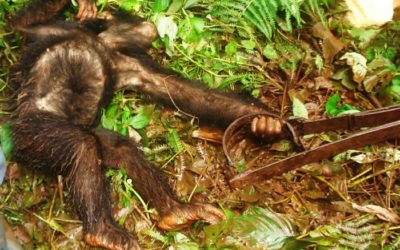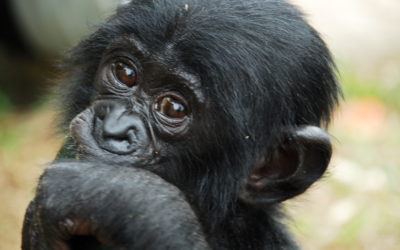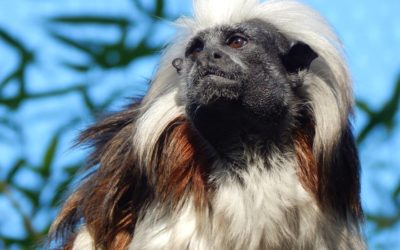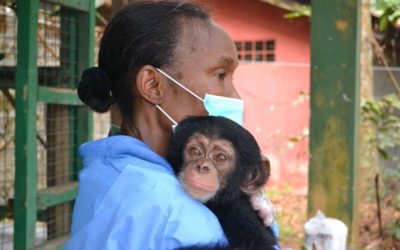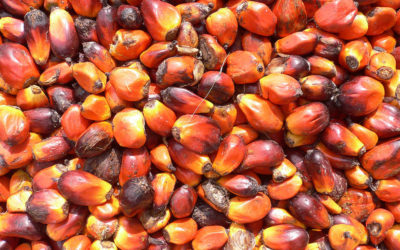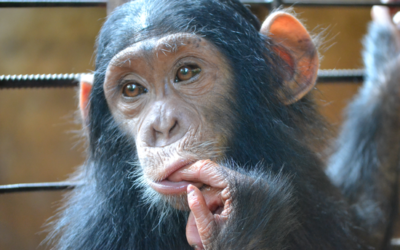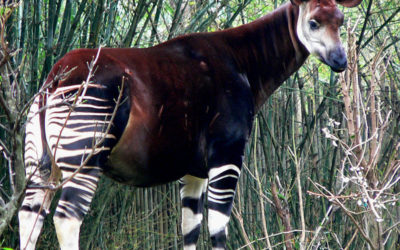Celebrate the Unknown Great Ape on World Bonobo Day!
Our closest relatives desperately need you to save them from extinction. There may only be 15,000 left.
By Natasha Tworoski
Finally! A reason for everyone, single or not, to celebrate February 14th! 2017 will mark the very first annual World Bonobo Day, spreading love of this rare great ape to all.
In 2015, conservationist Ashley Stone founded The Bonobo Project, a non-profit dedicated to raising awareness about bonobos while also aiding in the conservation of this incredible species. Already a platform for uniting bonobo conservationists, rescuers and admirers worldwide, The Bonobo Project is also responsible for creating this new reason to celebrate an amazing species.
It can be hard to gain momentum in the effort to protect bonobos from extinction. Why? Because the first question you usually get is, “What is a bonobo?” This great ape species is found only in the Democratic Republic of Congo and diverged from chimpanzees about 2 million years ago. This means the bonobo is also our closest relative, just like the chimpanzee. Also like the chimpanzee, they are an endangered species and their numbers are decreasing.
It’s estimated that there are fewer than 50,000 bonobos left, and possibly as few as 15,000.
PASA has joined The Bonobo Project to bring conservation organizations together and celebrate the first World Bonobo Day. We have committed to raising $2,000 as part of the crowdfunding campaign for World Bonobo Day – but we can only do it with your help.
The bonobos need your help. If we don’t all contribute, this amazing species may soon disappear forever.
Please click here to help us reach our goal of raising $2,000 before February 14!
Bonobos who have been confiscated from the black market bushmeat and illicit pet trade have one place to go: PASA member Lola ya Bonobo. No other sanctuary in the world is able to rescue orphaned bonobos! Founded in 1994 during a violent civil war in the Democratic Republic of Congo, Lola ya Bonobo has successfully reintroduced bonobos back to the wild on a protected reserve in northern DRC and they are currently preparing to do it again early in 2017!
Sadly, some of the bonobos they rescue are too traumatized from the terror of being taken away from their family at such a young age and do not develop all the skills needed to survive in the wild. For those individuals, they will always have a safe home living among other bonobos across Lola ya Bonobo’s 75 acres of forests, where diligent caretakers make sure they always have what they need.
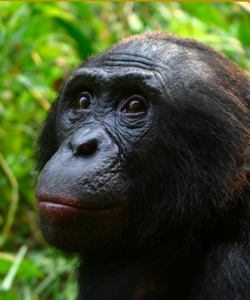
Along with chimpanzees, bonobos are our closest relatives in the primate world. And like chimpanzees, they face the threat of extinction.
Bonobos like this youngster rescued from the black market bushmeat and illicit pet trade come to Lola ya Bonobo Sanctuary orphaned and often traumatized.
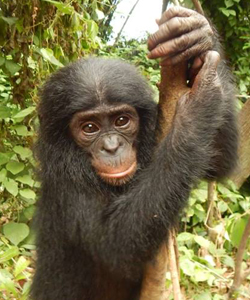
Next Posts
We All Get By With a Little Help from Our Friends
We All Get By With a Little Help from Our Friends It took a human to show Nina how to care for her new son. By Natasha Tworoski When humans prepare to have their first baby, it can be a nerve-wracking time filled with uncertainty. Fortunately, there are countless...
How Can You Reduce Climate Change by Helping Protect Great Apes?
How Can You Reduce Climate Change by Helping Protect Great Apes? New Data Show that Climate Change Is Causing Massive Tree Die-Offs in Africa By Natasha Tworoski It’s hard to find a place on the planet where scientific evidence isn’t showing global climate change...
Groundbreaking Ivory Ban in China Signifies Good News for All Wildlife
Groundbreaking Ivory Ban in China Signifies Good News for All Wildlife Ban Includes Closure of 34 Processing Factories and 143 Trade Venues By Natasha Tworoski One of Africa’s most iconic animals, elephants have undergone a devastating surge in poaching in the past...
Bushmeat Crisis
Bushmeat Crisis In West Africa and the Congo Basin, Bushmeat is Now the Leading Threatto Great Apes and Monkeys By Natasha Tworoski While the term “bushmeat” can simply stand for any wild animal killed for the purpose of eating its meat, most often in media it is used...
Sanctuaries Unaffected by Political Unrest in Democratic Republic of Congo
Sanctuaries Unaffected by Political Unrestin Democratic Republic of Congo Tensions Remain High As At Least 26 Protesters Are Killed By Natasha Tworoski Tensions have been high this week in the Democratic Republic of Congo, as December 19th marked the end of President...
Empowering Women Through Conservation
Empowering Women Through Conservation Offering Opportunities for Women Is a Responsibility Conservationists Should Consider By Natasha Tworoski Conservation efforts can often carry a despairing feeling of moral conflict, particularly in countries with high levels of...
The Growing Crisis of Great Ape Smuggling
The Growing Crisis of Great Ape Smuggling New Data Shows that Illegal Great Ape Smuggling Is Even More Dire than We Realized By Natasha Tworoski The great ape crisis is rapidly escalating. Eastern gorillas, Western chimpanzees and Bornean orangutans were recently...
The Devastation of Palm Oil is Now Spreading to African Countries
The Devastation of Palm Oil is Now Spreading to African Countries By Natasha Tworoski The overwhelming demand for palm oil is well-known for its horrifying impact in eastern Asia, particularly in Malaysia and Indonesia. However, growing demand means...
Protecting Primates in the Democratic Republic of Congo
Protecting Primates in the Democratic Republic of Congo By Natasha Tworoski The Democratic Republic of Congo is home to three PASA sanctuaries: Lola ya Bonobo, JACK (Jeunes Animaux Confisques au Katanga) and the Centre de Rehabilitation des Primates de Lwiro (CRPL)....
Democratic Republic Of Congo: On the Brink of a New Wave of Violence?
Democratic Republic Of Congo: On the Brink of a New Wave of Violence? By Natasha Tworoski A country that has faced a long history of violence and political instability, the Democratic Republic of Congo (DRC) is teetering on the brink of a new wave of violence. As the...

